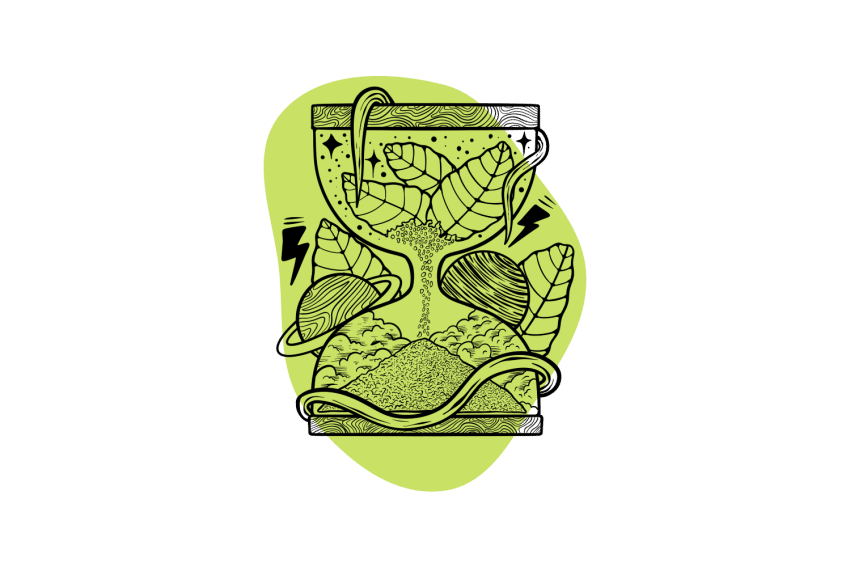Kratom’s Side Effects & How to Reduce the Risks
Kratom isn’t the scary drug some make it out to be, but there are some risks to be aware of.

Kratom is a herbal extract that provides many benefits, from relieving muscle pain to helping with headaches and anxiety. It also boosts energy levels and helps manage insomnia.
For centuries, communities in Southeast Asia have revered kratom for its medicinal qualities. However, it has only recently become popular in the United States, where it is available online or at smoke shops.
Despite its many benefits, kratom does have the potential for addiction and some side effects if used incorrectly.
Is kratom bad for you? Normally, no. But it is important to exercise caution when using it. Let’s look into what you need to know before safely consuming kratom.
What is Kratom?
Kratom comes from the leaves of the Mitragyna speciosa tree. This tree is native to many parts of Southeast Asia, including Thailand and Malaysia.
A popular herbal remedy for many ailments, the kratom plant comes from the same family as the coffee plant.
Kratom leaves are active from simply chewing them, but since it has a bitter taste, most people today take kratom as a pill or in powder form mixed into a beverage. Many still brew the leaves as tea.

Kratom’s active ingredients are alkaloids — mitragynine and 7-hydroxymitragynine — which affect the same brain receptors as opioids. This means those who use it may experience euphoria, increased alertness and energy levels, pain relief, sedation, and other effects similar to opiate drugs such as morphine or heroin.
Opiate users who want to wean off the drug have reported that kratom has been helpful due to this.
The effects of kratom vary as it acts as a stimulant in low doses but has sedative effects at higher doses.
Related: Kratom vs. Cannabis: Key Differences You Should Know About.
How Safe Is Kratom?
When used responsibly, kratom is safe for most people. The World Health Organization (WHO) reviewed kratom in 2021 and determined that it does not pose a risk to the public and should not be a controlled substance.
The fears surrounding kratom stem from its actions on the opioid receptors and because it’s linked to some deaths — almost all of which involved other drugs, like opioids, benzodiazepines, and cocaine.
We’ll discuss what “responsible use” looks like further down.
What Are Kratom’s Side Effects?
Kratom’s side effects vary from mild to severe, depending on the user’s tolerance, health, the dose of kratom, and how often they take it. Side effects include:
Vomiting & Nausea
Those new to kratom report feeling sick to their stomachs and vomiting after their first use [1]. Seasoned users advise halving the original dosage before trying it again.
Nausea and vomiting are also likely when taking kratom on an empty stomach, as this accelerates absorption.

Another reason for nausea could be the body’s reaction to the plant’s fibrous nature.
If you’re an experienced user but start feeling sick or throwing up, you may be using more than your body can tolerate.
Lethargy & Sedation
High doses of kratom can have strong sedative effects, so those high on it may appear lethargic and slow-moving. However, they usually also feel content and euphoric.
Kratom can give people an energy boost when used sparingly. Once it wears off, the user will feel calm and relaxed.
Regular use can change its effects on the body. You may develop a tolerance to its stimulating effects over time and become too lethargic to move after the relaxing phase.

Regular use could also lead to chronic fatigue. Your body may struggle to produce energy due to the breakdown of your dopamine and adrenaline systems. You may also need to take higher doses of kratom to stay awake.
Dizziness
Dizziness is among the most common side effects of kratom use. This is especially common when a user overdoses, takes a high dose on an empty stomach, or does not hydrate enough first.
In addition, users may also experience feeling sick, blurry vision, and body tremors. Together, users have nicknamed these common symptoms “the wobbles.”
Wobbles
Kratom wobbles, also known as nystagmus, is a condition in which your eyes twitch, making it difficult to focus and see properly after consuming kratom. An elderly woman using kratom to treat her opioid withdrawal symptoms reported having wavy vision and oscillopsia (jumpy vision). Her tests revealed she had nystagmus.
Typically a symptom of overdose, it could affect even new kratom users who mistakenly consume a high dose. The disturbed vision may also cause the user to feel dizzy and have motion sickness or brain fog.

Occasionally, this can make it impossible for you to function normally throughout the day.
Many consider the following kratom strains to trigger kratom wobbles more than others. While only anecdotal, many believe this to be because of their higher alkaloid level and chemical composition:
- Bali Kratom
- Borneo Kratom
- Indo Kratom
- Maeng Da Kratom
- Thai Kratom
Anecdotal evidence from users on online forums suggests that, while unpleasant, the wobbles don’t last long.
Constipation
Kratom and constipation often go hand in hand. Drugs with opioid-like effects frequently slow the movement of the bowels. It is also common for them to inhibit gastric emptying and peristalsis (involuntary wave-like muscle contractions in the digestive system) [2].
As a result, there is a delay in drug absorption and an increase in fluid absorption. A shortage of fluid in the intestine causes excrement to harden, leaving the user constipated.
Constipation usually develops after a few days of consistent kratom use. However, some beginners may suffer from it after their first dose.
If you become constipated after using kratom, consider lowering your intake or taking a break. Chronic constipation can cause complications like hemorrhoids, anal fissures, and fecal impaction.
Brain Fog
Kratom use can affect cognitive function [3]. Some users taking high doses have claimed to experience “brain fog” while on kratom.
It impairs their ability to think clearly, and speak coherently and causes them to forget things. While the brain fog fades after a couple of hours, it usually impairs normal functioning, often affecting work and home life.
Stimulating strains, on the other hand, cause users to experience brain fog after the high. Like crashing from caffeine, this can cause the user to experience fatigue.
Brain fog created by constant use could theoretically result in long-term problems. This includes problems like memory loss, attention deficiency, spatial planning, and executive functioning difficulties.
Anxiety
Kratom is a powerful substance that can help those with anxiety. However, misuse can develop when people turn to substances as a crutch instead of seeking medical help for their underlying problems.

One study showed that while kratom was useful in treating anxiety and depression, its effects were short-lived [4]. The study stated this came when the former relief method wasn’t working, causing them to become more anxious about their situation.
In some ways, kratom use might actually increase anxiety rather than alleviate it. Someone suffering from an episode of brain fog could become very confused and irritable. As the symptoms pile up, anxiety may build, leading to a panic attack when they can’t handle it anymore.
Kratom may also stimulate the adrenal system and activate the fight-or-flight response, both of which are a result of anxiety or panic. Continued use of kratom could cause adrenal insufficiency, where the body cannot produce the cortisol needed to regulate blood pressure, manage the body’s stress response, or break down proteins and lipids.
Those with a tolerance to the drug may experience intense cravings early in the morning or in the middle of the night as their adrenal glands try to restore balance.
Aside from the above-mentioned common side effects, other recognized but uncommon side effects of kratom usage include [5]:
- Mania and psychosis symptoms in individuals with psychotic illnesses
- Hallucinations and delusions
- Confusion and short-term memory problems
- Rashes or allergies affecting the skin, sinuses, or digestive tract
What Are the Long-Term Side Effects of Kratom?
Because kratom only entered Western research recently, there haven’t been many long-term studies on its medical application and efficacy, as well as its adverse effects. We need more research in these areas.
Understandably, misusing the substance can heighten risks and cause complications. A few studies support this, suggesting that kratom has long-term detrimental effects.
That said, the overuse of any substance over an extended period can result in problems.
Addiction
Kratom is addictive for many users. With long-term heavy use, people can experience withdrawal symptoms, including irritability, loss of appetite, and muscle aches.
Liver Damage
Is Kratom bad for your liver? People with healthy livers should have no issues metabolizing kratom and won’t suffer any liver damage.
Long-term, recreational use of kratom is linked to acute liver damage. This is rare and has only been seen in the West so far, even though Southeast Asia has used kratom for hundreds of years [6].
Damage usually starts between 1 and 8 weeks after regular usage of kratom. Most reported symptoms resemble those of liver toxicity, such as fatigue, nausea, dark urine, and jaundice.

Kratom contains a high concentration of the alkaloid mitragynine. The breakdown of this chemical comes largely from the liver enzyme CYP2D6, with some support from CYP3A4 and CYP2C9.
If someone uses drugs that impact these enzymes, liver injury is more likely.
Kidney Damage
Kratom and kidney damage aren’t linked since kratom doesn’t damage them directly [7]. Only when the user has a damaged liver do the kidneys have to work harder to remove toxins from the body. Instead of passing through the liver, toxins travel into the kidney, potentially damaging it.
It is unlikely that kratom will cause kidney damage in healthy individuals. However, those with pre-existing chronic liver problems should avoid using it.
Emotional Imbalance
Kratom can affect your emotional health in different ways. For one, it can make you more prone to mood swings. You might feel euphoric for a while and then incredibly depressed after.
Many people take kratom to treat depression and anxiety, but it does not cure these diseases; it only numbs the mind. It could also impact one’s emotions, resulting in issues in one’s daily life.
Several kratom users reported the following:
Irritability
Like opioid users, regular kratom users tend to have a short fuse and difficulty controlling their emotions. This could be because, as an analgesic, kratom might momentarily impair one’s ability to empathize with others, causing someone to act bluntly and irrationally.

Apathy
Research suggests kratom may downregulate dopamine and other emotional receptors, making users numb to positive emotions. As a result, it may leave users feeling depressed and unmotivated. Those who suffer from depression often develop a reliance on kratom to feel happy.
However, more research is needed to demonstrate kratom’s role in desensitizing humans to emotional stimuli.
Hyperalgesia
Many users, especially the elderly, turn to kratom for its analgesic effects, viewing it as a more natural alternative to opioids. However, chronically using painkillers like opioids could have the opposite effect [8].
Oversensitivity to pain, or hyperalgesia, results in a person experiencing pain at a higher intensity. Although kratom-induced hyperalgesia is weaker than that of opioids, it is still important to be aware of the possibility.
Low Libido
Many people promote kratom as an aphrodisiac, claiming it can improve their performance in bed. However, very few studies support this, and many attribute it to the fact that kratom can increase energy.
Additional benefits supporting this claim include kratom’s ability to reduce performance anxiety and stimulate euphoria. Together, these effects could enhance the total experience.
Still, overuse of kratom might have negative consequences, disrupting one’s hormonal balance and lowering energy levels. This may result in reduced libido.

This is probably because kratom can elevate prolactin, subsequently reducing testosterone production, leading to a lower libido and poor sexual performance.
Also see: How Long Does Kratom Stay in the System?
Minimizing Kratom’s Side Effects & Risks
One common denominator in these side effects is the prolonged or consistent use of kratom, especially in high doses.
Naturally, the best way to avoid these effects is to not use kratom at all. However, should you use kratom, take the following steps to reduce the risk of side effects:
- Never use kratom with other substances, medications, or supplements without knowing how they’ll interact.
- Limit your kratom use and take tolerance breaks.
- Take the right dose for your specific need and build, and only when necessary.
- Take every dose with a meal or snack to prevent stomach issues and nausea.
- Be well-hydrated to prevent constipation and stomach issues.
- Only buy kratom from reputable vendors to avoid contaminated or adulterated products.
Consume Kratom Safely
There are several safe methods for taking kratom, and everyone has a preference.
Most kratom tea users find their experience soothing, even though the taste is bitter.
Taking kratom as tea causes the alkaloids to enter the digestive system and bloodstream more slowly, resulting in gradual effects.
Other people buy kratom capsules, extracts, tinctures, or one of the many new products that constantly pop up.
Find what works for you, but always check the labels for extracts and tinctures since the potency varies, and they can be quite strong, making them more likely to cause side effects.
Never smoke, vape, or snort kratom — these methods are not worth the risks and are less effective.
Find the Right Kratom Dose
When it comes to kratom, the safest dose is not always the same for everyone — factors like metabolism, age, gender, weight, diet, and tolerance come into play.
Generally speaking, the safest dose will be the smallest one that still provides the desired effect.
Here are the general dosing guidelines:
- Small dose: 1–3 g
- Medium dose: 4–6 g
- Large dose: 7–9 g
- Hefty dose: 10–12 g
Smaller amounts are more energizing, while larger doses are more sedating and better for pain. Start on the low end and work your way up until you get the effects you’re looking for. This keeps you from taking more than you need to.
Take Tolerance Breaks
As tolerance and dependency could develop, kratom is not a safe drug to use regularly.
If your optimal dose is no longer effective, don’t increase your dosage since this means your body is becoming tolerant, which can lead to addiction. Taking more will put you at risk of long-term side effects.
Tolerance breaks can help you avoid tolerance and addiction. The general consensus is to take a few days off every week and one week off every month.
Avoid Medications When Using Kratom
Kratom’s primary alkaloid, mitragynine, may inhibit CYP450, an enzyme that breaks down a range of drugs and dietary supplements [9]. Using kratom in conjunction with any drugs metabolized by CYP450 increases the risk of side effects.
These drugs include, but are not limited to:
- Anti-epileptic drugs
- Blood pressure medications
- Blood thinners
- Oral Contraceptive Pills (OCPs)
- Statin medications
- Theophylline
The effects of medications like anxiolytics (anti-anxiety medications or minor tranquilizers), muscle relaxants, and other sedatives can intensify when used in conjunction with kratom.
Final Thoughts: Avoiding Kratom’s Common Side Effects
Kratom has shown great promise as a natural analgesic, anti-anxiety drug, and energizing supplement. It’s possible to minimize many of its negative side effects by regulating the dosage and ensuring proper and careful consumption.
We recommend that you start with the lowest dose possible and not take any more if you find yourself becoming tolerant of its effects. If you need help determining how much kratom is suitable for you, consult your doctor.
References
- Singh, V., Mulla, N., Wilson, J. L., Umansky, A., Lee, J., Stead, T., & Ganti, L. (2020). Intractable nausea and vomiting in naïve ingestion of kratom for analgesia. International Journal of Emergency Medicine, 13(1), 1-4.
- Murphy, D. B., Sutton, J. A., Prescott, L. F., & Murphy, M. B. (1997). Opioid-induced delay in gastric emptying: a peripheral mechanism in humans. The Journal of the American Society of Anesthesiologists, 87(4), 765-770.
- Singh, D., Narayanan, S., Müller, C. P., Vicknasingam, B., Yücel, M., Ho, E. T. W., … & Mansor, S. M. (2019). Long-term cognitive effects of Kratom (Mitragyna speciosa Korth.) use. Journal of psychoactive drugs, 51(1), 19-27.
- Müller, E., Hillemacher, T., & Müller, C. P. (2021). Kratom use for depression/anxiety self-management: challenges during the COVID-19 pandemic–A case report. Heliyon, 7(5), e07039.
- Cutlip, H. A., Bushman, E., Thottumari, L., Mogallapu, R., & Ang-Rabanes, M. (2021). A Case Report of Kratom-Induced Psychosis. Cureus, 13(6).
- Dorman, C., Wong, M., & Khan, A. (2015). Cholestatic hepatitis from prolonged kratom use: a case report. Hepatology, 61(3), 1086-1087.
- Veltri, C., & Grundmann, O. (2019). Current perspectives on the impact of Kratom use. Substance abuse and rehabilitation, 10, 23.
- Tompkins, D. A., & Campbell, C. M. (2011). Opioid-induced hyperalgesia: clinically relevant or extraneous research phenomenon?. Current pain and headache reports, 15(2), 129-136.
- Hanapi, N. A., Ismail, S., & Mansor, S. M. (2013). Inhibitory effect of mitragynine on human cytochrome P450 enzyme activities. Pharmacognosy Research, 5(4), 241.









